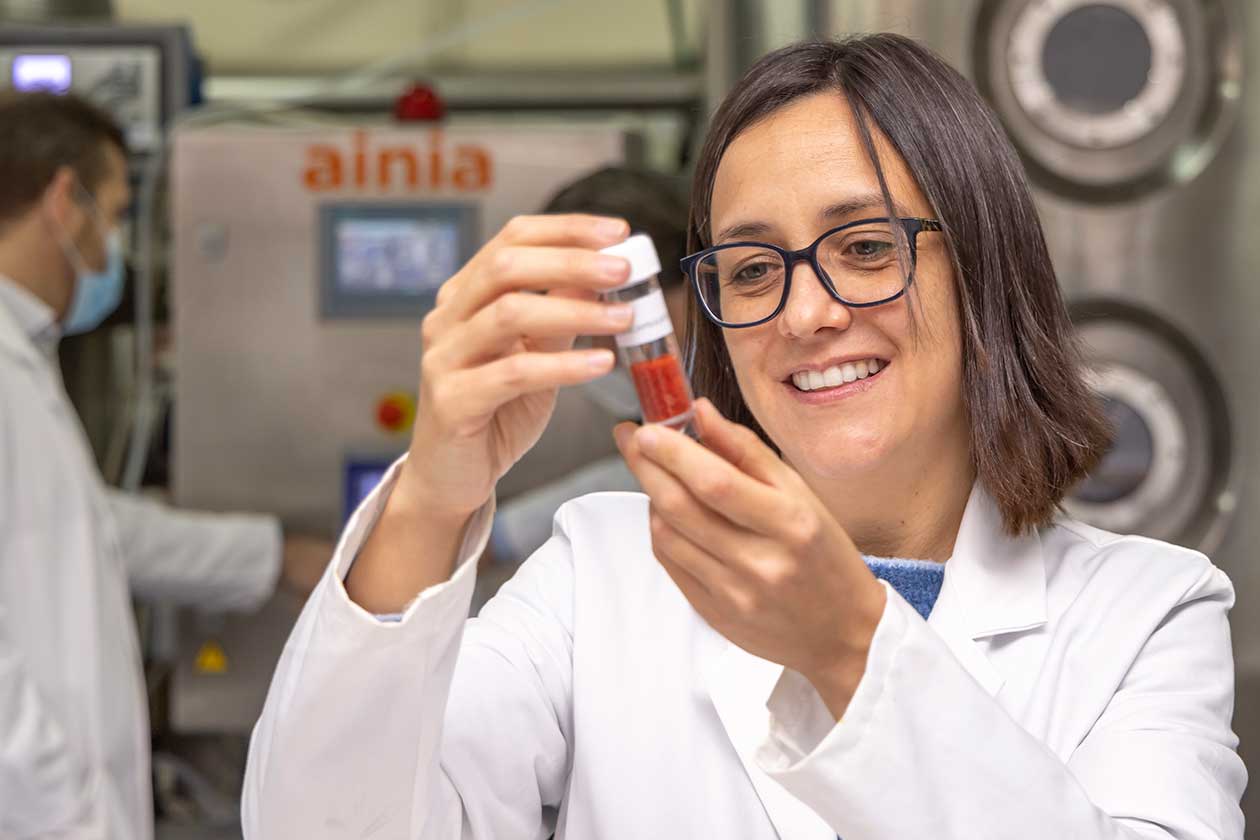The cosmetics industry increasingly demands products and ingredients with advanced and specific properties that address various dermal issues such as skin aging. These solutions can enhance their effectiveness and efficiency if therapeutic molecules are targeted to the site where they need to exert their effect. Targeted and controlled release of such molecules is a field that has been studied for decades but has certain limitations that can be overcome through the use of advanced microencapsulation materials. At AINIA, we are studying and evaluating new advanced coating materials for the microencapsulation of sensitive compounds applicable to the cosmetics industry. Let us tell you more about it.
The cosmetics industry is a sector that is constantly evolving, innovating to offer products with advanced properties to consumers. Currently, there is a trend and a high demand for natural products, whose formulations are primarily composed of natural ingredients. Additionally, consumers demand skincare products that are more effective, allowing them to address specific issues such as aging more effectively and quickly. These circumstances lead to an increasing demand in the cosmetics industry for products and ingredients with advanced properties.
Consumers of skincare products generally seek effective products that address certain dermal issues through the application of cream, without the need for costly surgeries or aesthetic treatments. Therefore, it is necessary to offer advanced products with very specific properties that address these issues.
To address these needs, at AINIA, through the MAREA project, we are studying and evaluating new materials capable of forming controlled release systems through microencapsulation processes. This way, the therapeutic molecule can be exclusively targeted to the skin’s target cells and released at that specific point.
Targeted release systems for cosmetic products
The targeted and controlled release of therapeutic molecules is a field that has been studied for decades, initially garnering significant interest in the pharmaceutical industry and later extending to the cosmetic and food industries. This type of release is defined as the process of delivering a specific therapeutic dose to a defined tissue or organ, within a predefined timeframe, using some form of formulation or device. However, these controlled release systems have limitations, including the challenge of releasing active molecules that are highly sensitive and have low bioavailability and pharmacokinetics on their own. One way to overcome this limitation is through microencapsulation processes.
Challenges of controlled release for cosmetic products through microencapsulation
- Biopolymers Compatible with the Human Body: Since the selection of encapsulation material is a critical point when designing a microencapsulation process that results in a controlled release system of a therapeutic molecule, it is necessary to investigate the capability of certain biopolymers compatible with the human body for use in controlled release systems. These biopolymers exhibit a special affinity for specific release points in the body, as well as high in vivo degradation, ultimately leaving the human body in the form of biocompatible byproducts.
- Specific Transport of Encapsulated Molecules to Target Cells: One of the main challenges of controlled or targeted release is the specific transport of encapsulated molecules to target cells. To overcome this limitation, the external surface of encapsulation materials can be functionalized with biomolecules capable of interacting specifically with receptors overexpressed in the cells of interest. These biomolecules can be targeted against various membrane molecules, such as mucins or integrins. Among the different biomolecules used for controlled release of molecules, peptides are good candidates due to their biological properties (biocompatibility, stability, and low immunogenicity) and ease of production.
Microcapsules with Advanced Properties for the Cosmetic Sector
The MAREA project, supported by the Valencian Institute of Business Competitiveness (IVACE) and FEDER funds, aims to study and evaluate new advanced coating materials for use in microencapsulation processes to produce microcapsules with novel properties such as targeted release to skin target cells. These microcapsules will be applied in the cosmetic sector as an ingredient in cosmetic formulations for dermal use. In this project, we will work with two types of advanced encapsulation materials that will enable the achievement of targeted release systems of molecules to target cells:
- Polymeric base materials with biodegradable and biocompatible properties
- Exosomes. By their very nature, they already exhibit some directionality towards target cells and do not require functionalization, unlike polymeric base materials, which do need functionalization.
Therefore, with this project, we aim to promote the study and development of biopolymers functionalized with peptides for the controlled release of active substances towards the target cells of the skin for use in the cosmetic sector.
Pre-clinical efficacy trials aimed at the cosmetics industry
The search for evidence supporting cosmetic effectiveness claims should be an integral part of cosmetic product development, not just as support for product effectiveness communication, as defined by European regulation (Guideline for the Evaluation of the Efficacy of Cosmetic Products by COLIPA, The European Cosmetic and Perfumery Association). Within pre-clinical studies are in vitro studies using cellular models. The use of these cellular models is gaining importance due to significant advances in understanding the complex molecular processes that regulate and control the behavior of the different cells that make up the skin, both individually and within tissues. Among the many advantages they offer are “personalization” based on the product or sought indication, the duration of the trial, and variability.
To study and evaluate the effectiveness of the developed controlled release systems, it is necessary to conduct complex designs of ad hoc cells because there is a growing interest in understanding the mechanism of action of the molecules of interest in the cells where they are applied. With the project, knowledge in this area will be expanded as we will study and design a complex model of human skin, with different cell types, to study targeted release and the specific effectiveness of the microencapsulated active substance in the various developed encapsulation materials.





